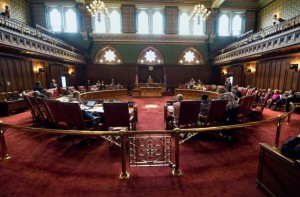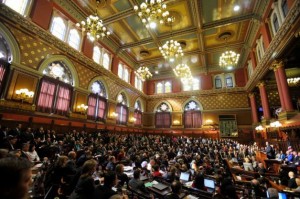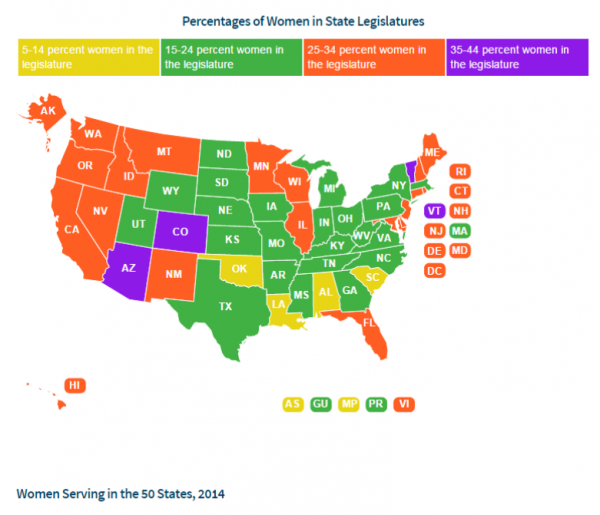CT Ranks #7 in USA in Women in State Legislature; Number Unchanged in State, Drops Nationally
/Election results indicate that there will be fewer women serving in state legislatures around the country in 2015 than this year. In Connecticut, the number remains unchanged from this year, slightly below the recent peak in 2009. Approximately 1,750 women legislators will be in office in 2015, compared to approximately 1,784.this year. The national percentage of female to male legislators will be approximately 23.7 percent, a slight decrease from the 2014 figure of 24.2 percent.
According to the National Conference of State Legislatures (NCSL), Connecticut will have 8 women in the State Senate and 45 women in the House of Representatives when the 2015 session opens. That is a total of 53 women holding 28.3 percent of the 187 seats, ranking the state tied at #7 in the number of women serving in the state legislature and at#14 in the percentage of women in the legislature. Although a number of office-holders changed, the numbers remained constant from 2014 to 2015 in Connecticut.
The national percentage of female state legislatures reached 20 percent in the 1992 election, but has not grown more than 4.5 percentage points since then. Colorado is expected to have the highest percentage, 43 percent, of women serving, and Oklahoma the lowest at 12.1 percent. South Carolina, West Virginia and Wyoming will each have only one woman serving in their senates.

While the number of women in Connecticut's 36-seat Senate has remained relatively static for the past six years at 8 or 9, the representation of women among House members has dropped from 51 in 2009 to 45 in the upcoming 2015 session. In 2013, there were 46 women in the House and 9 women in the Senate – 29.4 percent of legislators. In 2009, the breakdown was 51 and 8, for a total of 59 – 31.6 percent of the legislature.
There will be one woman among legislative leaders. State Rep. Themis Klarides of Derby was chosen by her House Republican colleagues as their caucus leader, the first woman to be selected to lead the  Republicans. The House Speaker, House Majority Leader, Senate President Pro Tempore Senate Majority Leader, and Senate Republican Leader for the 2015 session are men, as was true in the previous legislative session. Connecticut has seen a woman Speaker of t
Republicans. The House Speaker, House Majority Leader, Senate President Pro Tempore Senate Majority Leader, and Senate Republican Leader for the 2015 session are men, as was true in the previous legislative session. Connecticut has seen a woman Speaker of t he House, but there has not been a woman selected to serve as Senate President Pro Tempore or Majority Leader.
he House, but there has not been a woman selected to serve as Senate President Pro Tempore or Majority Leader.
In other elected offices in Connecticut, three of the state’s six statewide Constitutional offices are held by women – Lieutenant Governor Nancy Wyman, Secretary of the State Denise Merrill and State Treasurer Denise Nappier. All three were re-elected this year. Of the state’s seven members of Congress, both U.S. Senators, Richard Blumenthal and Chris Murphy are men (and former state legislators) and two of five U.S. House members are women, Elizabeth Esty (a former state legislator) and Rosa DeLauro. Both House members were re-elected this year, as were Congressmen Joe Courtney, Jim Himes and John Larson.
NCSL points out that conventional wisdom has held that one reason women are less likely to run for office is because of greater family caregiving responsibilities. A recent study, however, found that family situation had no effect on a potential candidate’s ambition to run for office—and this held true for both women and men. Other factors that may be at play include women’s perceptions of their qualifications (women tend to think they are less qualified than men), and political party systems of candidate recruitment.
Looking ahead to the 2015 legislative sessions, the highest percentage of women in legislative bodies are in Colorado (42%), Vermont (41%), Minnesota (33%), Washington (33%), Nevada (32%), Arizona (31%), Illinois (31%), Oregon (31%), Alaska (30%), Maryland (30%), New Jersey (29%), Maine (29%), Hawaii (29%) and Connecticut (28%).
Based on returns from the 2014 election earlier this month, when state legislatures convene early next year, New Hampshire will have 112 women, Vermont will have 74, Minnesota will have 67, Maryland 56, Illinois 55, Maine 54, and Connecticut and Georgia, 53 each.
The partisan composition of women the nation’s 50 state legislatures is 683 Republicans and 1,058 Democrats. (As well as 4 Third Party office-holders and 10 non-partisan in Nebraska.)
Permanent Commission on the Status of Women, comments by women legislators






























